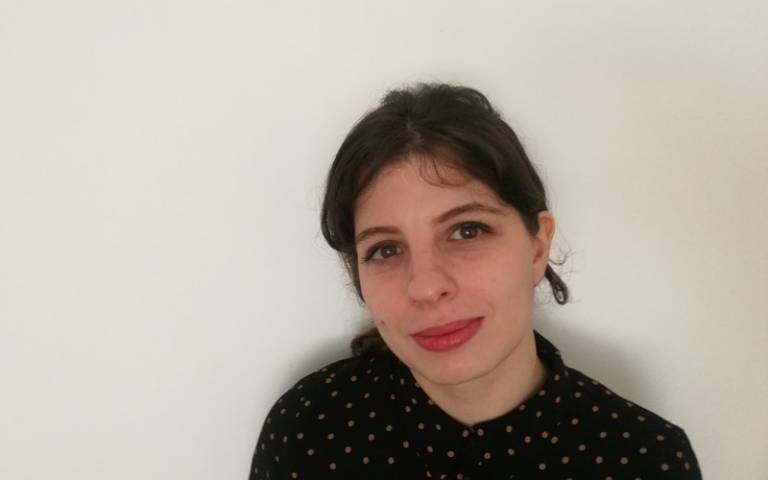HoA welcomes back Dr Hélia Marçal as a new lecturer in the History of Art, Materials & Technology
26 September 2020
UCL History of Art is delighted to welcome Dr Hélia Marçal to the department, where she joins us as a lecturer in the History of Art, Materials and Technology.

Hi Hélia – you did some teaching in the Department last year but have recently joined us as a full-time Lecturer in History of Art, Materials and Technology. Welcome! Can you tell us a little about yourself?
Thank you! I started working with the Department as a Fractional Teaching Fellow last year, and I am very happy to join the Department as a full-time Lecturer. I moved to London two years ago to work as the Contemporary Art Conservation and Research Fellow in the project Reshaping the Collectible: When Artworks Live in the Museum, at Tate. This project has had a great influence on my thinking, particularly because I was able to develop very good (and, hopefully, lasting) partnerships, and to learn with my colleagues working in collection care. Before my appointment at Tate, I was based in Lisbon, where I was developing my PhD research on conservation and display of performance art created during the Portuguese dictatorship and revolutionary process (which was awarded in 2018), and where I also worked briefly as a Science Manager in the Institute of Contemporary History (at NOVA University of Lisbon). I think I could be described as someone who is very curious about the natural and social world – and I truly think that is one of the reasons why I decided to pursue a route of studies at the intersection of art, philosophy, and natural sciences since early on in my undergraduate degree.
What does your research focus on?
My current research focuses on the care, historicisation, and memorialisation of performance art (or artworks and objects with performative features). I am very interested in understanding how the knowledge about all sorts of artworks and objects is produced, how matter and meaning are intertwined, and who is called in to participate in material practices of knowledge-making, such as conservation or art history. Probably due to the theoretical frameworks that I employ in my work – called new materialisms - my research also focuses on the ethical consequences of the ways in which knowledge is produced, asking questions like: which perspectives are we including and excluding when we collect or conserve artworks in a given way? How is our thinking impacted by the cultures of practice within which we are situated? This is the topic of my current book project, which draws on my PhD dissertation to explore current forms of activist performance to interrogate the wider politics of conservation of cultural heritage.
That sounds interesting! Which courses will you be teaching on this year, and how will they link with your research?
This year I will be teaching four courses, three of which are from our amazing History of Art, Materials and Technology BA: Introduction to Media and Technologies, Introduction to Art and Science, and Methods and Materials of Artists II. Additionally, I am also teaching Methodologies of Making, which is a course that looks at the ways of knowing and making of art history and art objects. One of the things that I will draw directly from my research is a way of thinking about science through art and vice-versa. I hope that I will be able to share my excitement for the ways in which materiality is entangled with art and knowledge making. In Introduction to Media and Technologies, we will look at media and the ways it was used in the production of cultural objects, focusing specifically on the materiality of the technologies of communication. Introduction to Art and Science will bring students into the marvellous world of the materials that make up the objects we call art. This module will allow our students to understand not only the matter of artworks but also how it changes and what triggers those changes. We will further explore the materialities of art in the course Methods and Materials of Artists II, looking at specific techniques and how they are performed. Methodologies of Making, in a way, brings together all of these ideas around making in a course that discusses frameworks of art production and making. We will touch on topics such as remaking, collecting, or conservation, engaging with theories of materiality to explore how histories of art are made, the workings of concepts such as artist or artwork, and how these are operated.
What are you most looking forward to about your new role at UCL History of Art?
I am looking forward to meeting the students and to working with them, and with everyone in the Department, as well as further collaborating with my colleagues across the Department and other UCL institutions. I am also looking forward to working with students in our great laboratory space - the Material Studies Laboratory - that is dedicated to the study of artworks and processes of art-making.
We have lots of new students joining us in September, and many returning for their second and third years. What advice would you give to these young art historians?
This has been quite an odd year, to say the least. I think that it has made everyone think differently about our relationship with the past and the future. My advice would be to think critically about the past, the present, and the future, and to situate yourself and be reflexive in your research and practice.
 Close
Close

